

RS Digital Tech and Planet Climate monitoring workshop note. The role of artificial intelligence in achieving the Sustainable Development Goals. Our review of relevant evidence shows that AI may act as an enabler on 134 targets (79%) across all SDGs, generally through a technological improvement, which may allow to overcome certain present limitations.

The Infrastructure Needs of the Digital Economy. The Internet already plays an indispensable role in the everyday life of billions.

Yet the surface is only being scratched. The potential to bring new and more advantages to individuals around the world, and to benefit billions more people as they gain access, has few limits. Many of these benefits could have their biggest impact in emerging markets; unfortunately, these are the countries in which Internet penetration and use often lag. Almost 3 billion connected consumers and businesses (as well as governments and other organizations) search, shop, socialize, transact, and interact every day using personal computers and, increasingly, a broadening range of mobile devices.
The digital economy, which contributed $2.3 trillion to GDP in the G-20 in 2010 and is expected to contribute more than $4 trillion to their GDP in 2016, is growing at 10 percent a year—significantly faster than the global economy as a whole. Complex Challenges. Economic and Social Survey of Asia and the Pacific 2019: Ambitions beyond growth. The relatively stable economic performance of Asia and the Pacific conceals increasing downside risks to regional progress in implementing the 2030 Agenda for Sustainable Development.
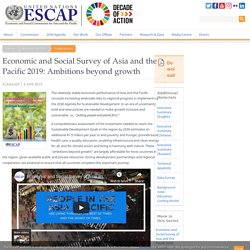
In an era of uncertainty, bold and wise policies are needed to make growth inclusive and sustainable, i.e., “putting people and planet first.” A comprehensive assessment of the investment needed to reach the Sustainable Development Goals in the region by 2030 estimates an additional $1.5 trillion per year to end poverty and hunger, provide basic health care, a quality education, enabling infrastructure and clean energy for all, and for climate action and living in harmony with nature. These “ambitions beyond growth” are largely affordable for most countries in the region, given available public and private resources. Strong development partnerships and regional cooperation are essential to ensure that all countries complete this important journey.
Chapter 1: Beyond economic growth. Horizon scan economic and legal. Lending to Low-Carbon Technologies.
Report that advises investors on how to understand the green energy sector. Points to likely greater investment in technologies such as solar and batteries, which would have knock-on impacts on monitoring technologies – tomaugust
190716 BEIS Green Finance Strategy Accessible Final. Insuring Nature to Ensure a Resilient Future. TNC is now working to replicate the model developed in Quintana Roo for other reefs and investigate whether other ecosystems such as coastal wetlands could benefit from a similar approach.
A concept for insuring nature. Stakeholders pay into the insurance product (e.g. hotels that rely on a reef, or residents that rely on natural flood defenses), and the policy pays out if that natural resource is damaged or needs maintenance. This would require monitoring of this natural capital. – tomaugust
To date, TNC has engaged with various partners including the United Nations Development Program, other international organizations and members of the insurance, reinsurance and international insurance brokers community.
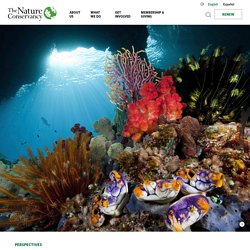
Prospective projects are currently being explored in the Caribbean, Asia, Australia and the United States. 'How do you transform an entire economy?' The firm taking on the climate funding problem. A growing number of governments, including of every Australian state, Britain and the European Union, have set targets of net-zero greenhouse gas emissions by 2050.

Infrastructure companies must embrace data and digital disruption. JVs will be attractive because they will enable infrastructure companies to join forces with technology providers, among others, to pool their know-how, expertise, technology, people and capital to deliver projects.
Infrastructure businesses advised to invest more in digital monitoring, IoT, Big Data, or fear being left behind. Potential competition for this industry from the tech industry. Seen as critical to future business, especially in the face of COVID. This links to smart cities. Leads to greater opportunities for environmental monitoring piggy backing on these systems – tomaugust

Data analytics -=business practices trends. Technology has brought some real game-changers to the world of business, one of which being data analytics – a tool currently seen as indispensable in every business, be it a startup or an established company.
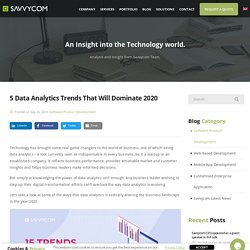
It reflects business performance, provides actionable market and customer insights and helps business leaders make informed decisions. OPAL Unlocking Private Sector Data Case Study. On Net Zero. Davies2019 Article EconomyVersusEnvironmentHowCor. Grantham Research Institute response to inquiry on decarbonisation of the UK economy and green finance.
Report into decarbonisation and the carbon economy and green finance. Green finance seem as a global movement where financial institutions take greater interest in environmentally conscious decisions such as investments. Carbon neutral UK, and concept of a carbon economy could drive innovation in the UK – tomaugust
Economics of climate. Cross currents: Big oil and the energy transition. Environmental Monitoring Market Growth, Trends and Forecast (2020-2025) The MarketWatch News Department was not involved in the creation of this content.
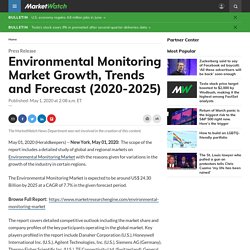
May 01, 2020 (Heraldkeepers) -- New York, May 01, 2020: The scope of the report includes a detailed study of global and regional markets on Environmental Monitoring Market with the reasons given for variations in the growth of the industry in certain regions. The Environmental Monitoring Market is expected to be around US$ 24.30 Billion by 2025 at a CAGR of 7.7% in the given forecast period. Browse Full Report: The report covers detailed competitive outlook including the market share and company profiles of the key participants operating in the global market.
Key players profiled in the report include Danaher Corporation (U.S.), Honeywell International Inc. Low-Cost Environmental Sensor Networks: Recent Advances and Future Directions. Introduction In recent years there has been a marked increase in the use of low-cost sensor networks (LCSNs) in the environmental sciences to address both pure research questions and applied management issues (Benedetti et al., 2010; Ojha et al., 2015; Prasad, 2015).
Measuring the rate of improvement of low-cost environmental sensor networks. – mattsmi123
As sensor networks with low-cost components in the setup, the rise of LCSNs has been driven by a number of factors including: the reduced cost of microcontrollers, communication modules and environmental sensors (Fisher et al., 2015), and the open science movement, which has seen the research community readily sharing designs, underlying software and firmware and data (Pearce, 2013).
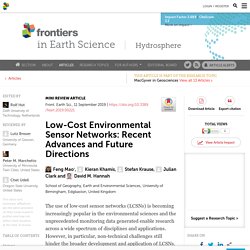
While there are some trade-offs with regards to robustness, calibration requirements and accuracy of low cost sensors when compared to high–end commercial sensors (Castell et al., 2017), the potential for greatly increased spatial coverage will facilitate new insights into environmental process dynamics (Krause et al., 2015). Methods Figure 1. A New Paradigm in Earth Environmental Monitoring with the CYGNSS Small Satellite Constellation. Differential Drag Orbit Configuration All eight satellites in the CYGNSS constellation were launched on 15 December 2016 into a nearly circular 520 km altitude orbit on a single Pegasus XL rocket.
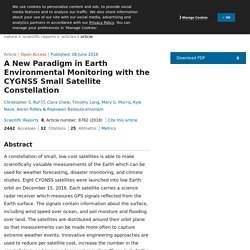
Sensor quality vs price EU Commission. Cloud Computing: The Digital Infrastructure Powering Today's Businesses. Not too long ago many described IT as a back-office function. Task Force on Climate-related Financial Disclosures.
Efforts to fund climate-change related efforts, for which environmental monitoring could apply – mattsmi123
Environmental land management: policy discussion.
New funding scheme for UK agriculture, replacing CAP - potentially a key mechanism to enable farmers to be rewarded for environmental monitoring. – mattsmi123